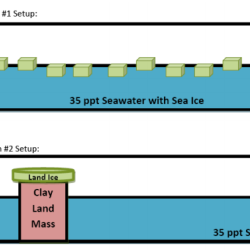Source Institutions
Source Institutions
Add to list Go to activity
Activity link broken? See if it's at the internet archive

In this activity, learners explore the concept of density-driven currents (thermohaline circulation) and how these currents are affected by climate change. Learners use colored ice cubes, water, and salt to explore density as it relates to salinity. This activity helps learners to understand the impact of glacial melt on sea level rise.
- 4 to 24 hours
- 1 to 2 hours
- $10 - $20 per group of students
- Ages 8 - adult
- Activity, Lesson/Lesson Plan
- English
Quick Guide
Materials List (per group of students)
- One sandwich-sized plastic bag that seals
- One plastic cup and spoon group
- Ice Cube Tray
- Food coloring: recommended blue or green
- Two clear, plastic shoebox sized containers (approximately 25.5 cm x 15 cm x 17.5 cm)
- Masking tape
- 1 multi colored package of modeling clay
- Access to warm water (tap water is fine)
- Pitcher
- 2 Heat lamps with bulb
- Salt (approximately ¼ cup)
- One refractometer or Hydrometer
- Permanent marker
- Ruler
- Measuring scale or balance
Subjects
-
Earth and Space Science
-
Earth Processes
- Geochemical Cycles
- Weather and Climate
-
Earth Structure
- Oceans and Water
- Atmosphere
-
Earth Processes
-
Life Sciences
-
Ecology
- Human Impact
-
Ecology
-
Physical Sciences
-
Heat and Thermodynamics
- Heat and Temperature
- Heat Transfer
-
Chemistry
- Solutions
-
States of Matter
- Liquids
-
Structure and Properties of Matter
- Volume and Density
-
Heat and Thermodynamics
-
The Nature of Science
- Science and Society
-
The Scientific Process
- Conducting Investigations
- Gathering Data
-
The Nature of Technology
-
Technology and Society
- Technology and the Environment
-
Technology and Society
Informal Categories
- Nature and Environment
Audience
To use this activity, learners need to:
- see
- see color
- read
- touch
Learning styles supported:
- Uses STEM to solve real-world problems
- Involves hands-on or lab activities
Other
Includes alignment to state and/or national standards:
Includes assesments for student learning:
This resource is part of:
Access Rights:
- Free access
By:
- Vernon Bell, Elizabeth ; Marshall, Brittney ; Bliss, Angela
Rights:
- All rights reserved, Centers for Ocean Sciences Education Excellence,
Funding Source:
- National Science Foundation, 0527849
